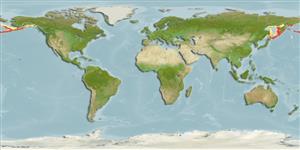Environment: milieu / climate zone / depth range / distribution range
Ökologie
seewasser bathydemersal; tiefenbereich 73 - 1660 m (Ref. 58496). Deep-water
North Pacific: Sakhalin (Russia), Bering Sea and Unalaska Island (Aleutian chain, Alaska).
Size / Gewicht / Alter
Maturity: Lm ? range ? - ? cm
Life cycle and mating behavior
Geschlechtsreife | Fortpflanzung | Ablaichen | Eier | Fecundity | Larven
Quast, J.C. and E.L. Hall, 1972. List of fishes of Alaska and adjacent waters with a guide to some of their literature. U.S. Dep. Commer., NOAA Tech. Rep. NMFS SSRF-658, 47 p. (Ref. 6876)
IUCN Rote Liste Status (Ref. 130435: Version 2024-1)
Bedrohung für Menschen
Harmless
Nutzung durch Menschen
Fischereien: nicht kommerziell
Tools
Zusatzinformationen
Download XML
Internet Quellen
Estimates based on models
Preferred temperature (Ref.
123201): 1.3 - 3.8, mean 2.2 °C (based on 209 cells).
Phylogenetic diversity index (Ref.
82804): PD
50 = 0.5000 [Uniqueness, from 0.5 = low to 2.0 = high].
Bayesian length-weight: a=0.00457 (0.00208 - 0.01002), b=3.17 (2.99 - 3.35), in cm total length, based on LWR estimates for this Genus-body shape (Ref.
93245).
Trophic level (Ref.
69278): 3.3 ±0.5 se; based on size and trophs of closest relatives
Widerstandsfähigkeit (Ref.
120179): hoch, Verdopplung der Population dauert weniger als 15 Monate. (Preliminary K or Fecundity.).
Fishing Vulnerability (Ref.
59153): Low vulnerability (10 of 100).
